Lectric XP 3.0 vs Ride1Up Portola vs Velotric Fold 1: Fight!
These three folding e-bikes are similar in specs and price, so which is best? We compared the performance test results to find a winner.

If you’re looking for an affordable entry point to e-biking, or you’re considering a folding e-bike to bring with you on RV trips or other family adventures, there’s no doubt you’ve heard of the Lectric XP 3.0.
After all, Lectric was largely catapulted to success after marketing to RV enthusiasts and other niche markets. The XP is the best-selling e-bike in the US for a reason: the brand essentially defined (and has since regularly redefined) the industry’s expected quality, spec, and performance metrics for affordable e-bikes.
Long story short, Lectric has enjoyed its time at the top, but it’s becoming increasingly difficult to stay there. With prestige comes attention; other brands took note of Lectric’s approach (and success) and adapted with the goal of overthrowing the reigning King.
Enter the Ride1Up Portola and the Velotric Fold 1. These newer entries to the affordable folding e-bike market are serious contenders for the throne. Both Lectric alternatives offer similar specs, a competitive price, and an appealing design, making them enticing to those seeking versatile, budget-friendly folding e-bikes.
As indicated by their well-earned places on our list of the best folding e-bikes, the Lectric XP 3.0, the Ride1UP Portola, and the Velotric Fold 1 are the cream of the crop for their cost and category. If you’re stuck between the three options, we’re here to help narrow down your selection!
In the following comparison review, we’ll walk you through the bikes’ features, feel, and functionality to find a first-rate folding e-bike worthy of your hard-earned funds.
|
Lectric XP 3.0 |
Ride1Up Portola |
Velotric Fold 1 |
Lectric XP 3.0 vs Ride1Up Portola vs Velotric Fold 1: Test Results & Key Specs
| Lectric XP 3.0 | Ride1Up Portola | Velotric Fold 1 | |
| Testing Results | |||
| Range Test – Maximum PAS | 28.6 miles, 1:47, 18.3 mph | 16.9 miles*, 1:02*, 16.2 mph | 22.3 miles, 1:17, 17.4 mph |
| Range Test – Minimum PAS | 44.3 miles, 5:35, 11.8 mph | 37.0 miles*, 3:08*, 11.8 mph *Note: Estimated based on our testing of a 672 Wh battery |
78.3 miles, 7:43, 10.2 mph |
| Hill Test – Throttle | 1:35, 11.4 mph | 1:30, 12.1 mph | 1:59, 9.1 mph |
| Hill Test – Pedal | 1:21, 13.4 mph | 1:17, 14.1 mph | 1:25, 12.8 mph |
| Speed Test | PAS 0: 12.8 MPH PAS 1: 15.4 MPH PAS 2: 17.0 MPH PAS 3: 20.0 MPH PAS 4: 20.0 MPH PAS 5: 20.0 MPH |
PAS 0: 8.7 MPH PAS 1: 9.9 MPH PAS 2: 11.9 MPH PAS 3:16.2 MPH PAS 4: 18.9 MPH PAS 5: 20.0 MPH |
PAS 0: 9.1 MPH PAS 1: 10.0 MPH PAS 2: 12.0 MPH PAS 3:14.9 MPH PAS 4: 17.1 MPH PAS 5: 20.0 MPH |
| Brake Test | 21’8” | 20’8” | 16’10” |
| Electrical | |||
| Motor | 500W hub motor, 1000W Peak, with 55 Nm of torque | 750W sustained geared hub motor, 960W Peak, 65 Nm torque | 750W hub motor, 1050W Peak, 70 Nm of torque |
| Battery | 48V, 500 Wh (672 Wh option available) | 48V, 499 Wh (643 Wh option available) | 48V, 608 Wh |
| Charger | 48V, 2A charger | 48V, 2A charger | 48V, 2A charger |
| Pedal Assist | PAS 1-5, cadence sensor with PWR Programming | PAS 1-5, cadence sensor with current-based cadence system | PAS 1-5, cadence sensor |
| Display | Backlit, heads-up LCD, B&W, centrally mounted | KD21C Adjustable Speed Display, B&W, handlebar-mounted | 1.8″ LCD, B&W, handlebar-mounted |
| Throttle | Half-twist throttle | Left-hand thumb throttle | Thumb-control, removable |
| Key Components | |||
| Frame | 6000 series aluminum | Alloy frame | Aluminum Alloy |
| Brakes | Front and rear hydraulic disc brakes paired with 180mm rotors, with motor inhibitors | Dual Piston Hydraulic Brakes, Electric Cut-Off Sensor, 180mm Rotors | Hydraulic Disc Brake, 180mm front and rear rotors, with power cutoff |
| Drivetrain | Shimano Tourney 7-speed | Shimano Altus 8-speed | SHIMANO Tourney 7-speed |
| Shifters (type) | Thumb-triggered handlebar shifter | Trigger shifter | Trigger shifter |
| Fork | Front oil suspension fork, 50mm travel | 80mm Suspension Travel, Hydraulic Lockout | Coil suspension 60mm travel with Lock-out |
| Rear Suspension | N/A | N/A | N/A |
| Tires | Puncture-resistant Lectric 20” x 3” fat tires with slime | 20”x3” Cross-Country Low-tread Tires | 20×3.0″ eBike puncture-resistant tires |
| Handlebar | 25″ width, low-rise | Straight Bars: 31.8mm Bar Clamp, 6° Sweep, 0° Rise, 600mm Width | Aluminum Alloy, Φ25.4mm, 660mm |
| Grips | Ergonomic grips | Ergonomic rubber grips | Durable ergonomic grips, lockable |
| Saddle | Custom designed saddle | DDK City Comfort Saddle | VELOTRIC urban comfort ergonomic seat |
| Kickstand | Included | Heavy duty adjustable length chainstay kickstand | Aluminum Alloy, rear mount |
| Rear Rack | 16L x 7W (150lb capacity)” | 130lbs Rated Loading Weight With Pannier Side Mount | Aluminum Alloy, integrated with frame, 120lb capacity |
| Lights | Integrated Front light and Tail light | 12V 40 Lux Front Light
6V Commuter Brake Light |
Front: 60 Lux high-output integrated LED, adjustable angle
Rear: Braking Indicator, integrated with rear rack |
| UL Certification | Certified to UL 2849, battery certified to UL 2271 | Battery manufactured to UL 2271 | Certified to UL 2849, battery certified to UL 2271 |
| Weight & Dimensions | |||
| Claimed Weight | 64 lbs | 59 lbs | 63 lbs |
| Battery Weight | 7 lbs | 8 lbs | 9 lbs |
| Maximum Payload | 330 lbs | 300 lbs | 440 lbs |
| Maximum Load On Racks (if applicable) | 150 lbs | 130 lbs | 120 lbs |
|
Lectric XP 3.0 |
Ride1Up Portola |
Velotric Fold 1 |
Lectric XP 3.0 vs Ride1Up Portola vs Velotric Fold 1: Range and Battery Capacity
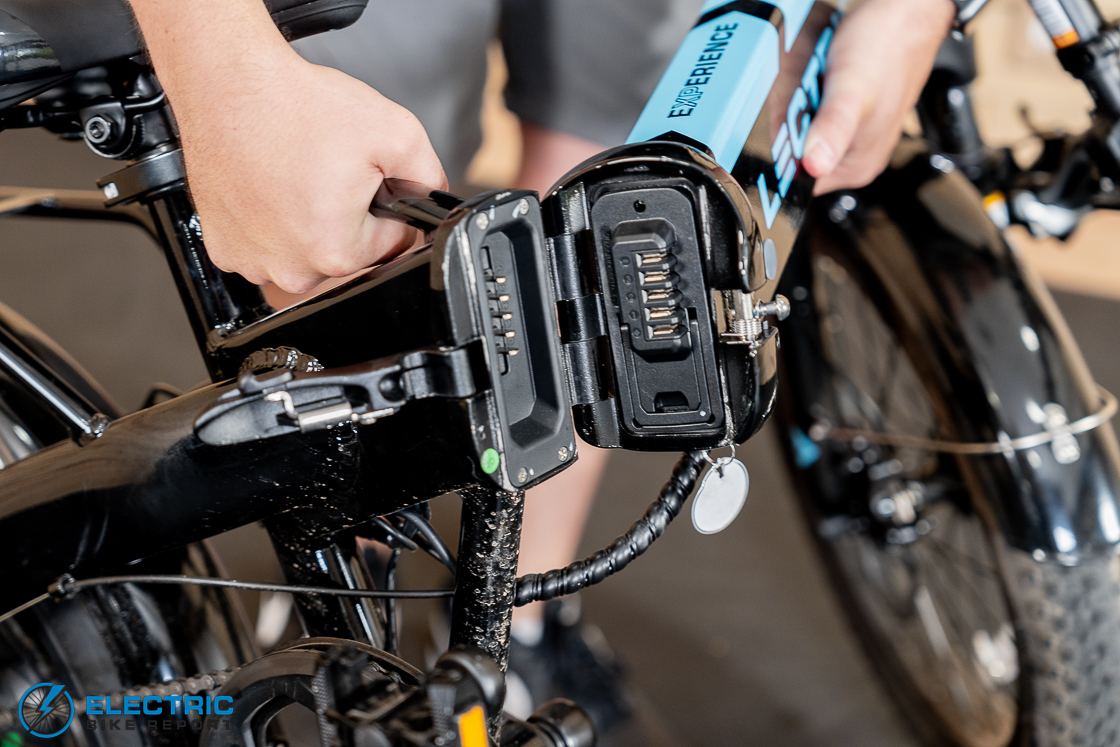
The XP 3.0’s 500 Wh battery is cleverly concealed inside the bike’s folding frame, though the frame must be unfolded to remove it.
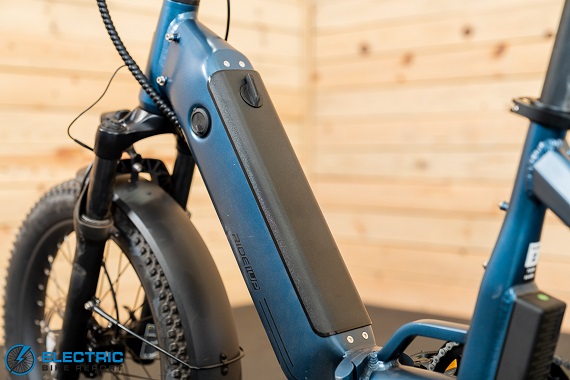
With two battery size options (499 Wh or 643 Wh), the Portola’s battery is fully integrated into the bike’s down tube.
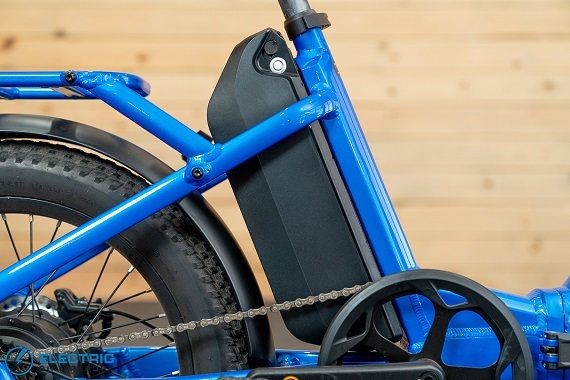
The Velotric Fold 1’s battery is placed behind its seat tube, giving the bike a balanced and agile feel.
Range Test Results:
| Lectric XP 3.0 | Ride1Up Portola | Velotric Fold 1 | |
| Max PAS | 28.6 miles, 1:47, 18.3 mph | 16.9 miles*, 1:02*, 16.2 mph | 22.3 miles, 1:17, 17.4 mph |
| Min PAS | 44.3 miles, 5:35, 11.8 mph | 37.0 miles*, 3:08*, 11.8 mph
*Note: Estimated based on our testing of a 672 Wh battery |
78.3 miles, 7:43, 10.2 mph |
In our Range Test, we tested the minimum and maximum range of all three bikes by riding in their highest and lowest pedal assist system (PAS) settings until their batteries expired.
As a caveat, we tested a pre-production model of the Portola with a 672-Wh battery that is larger than the 499 Wh and 643 Wh options currently offered. By determining its energy consumption in watt-hours per mile, we calculated the above estimates for the standard 499-Wh battery option.
In the big picture, all three bikes have solid range capabilities for their price. The XP 3.0 and the Portola differ in nominal motor output (500W vs 750W) but share the same size battery (500 Wh), so the differences in their results are logical. With a lower nominal power output, the XP was able to extend the mileage and ride time granted by its battery.
With highly impressive low-PAS results, the Fold 1 seemed to benefit from its slower programmed speed. By using minimal power and riding 1-2 mph slower than the Portola and the XP, it was able to travel literally leagues (a league is defined as a distance of 3 miles) beyond the others.
Based on our testing of the bikes’ base models, prospective buyers who prefer riding at high speeds may prefer the XP 3.0, while those concerned more with distance (and who are OK with riding slower) should look to the Fold 1 for its extreme long-distance capability.
When considering upgrade options—which, at the time of writing, brings the XP 3.0’s price up to that of the Fold 1—we expect Lectric’s bike to compete better with Velotric in the low-assist test (we estimate 59.5 miles) and greatly surpass it when using PAS 5. Our max-assist estimate is 38.5 miles, which is 16 miles beyond the results of the Fold 1.
For comparison purposes, we will focus solely on the base models. As such, we consider this section a tie between Lectric and Velotric since each performed best in one portion of the range test.
Lectric XP 3.0 vs Ride1Up Portola vs Velotric Fold 1: Power (Hill Test)
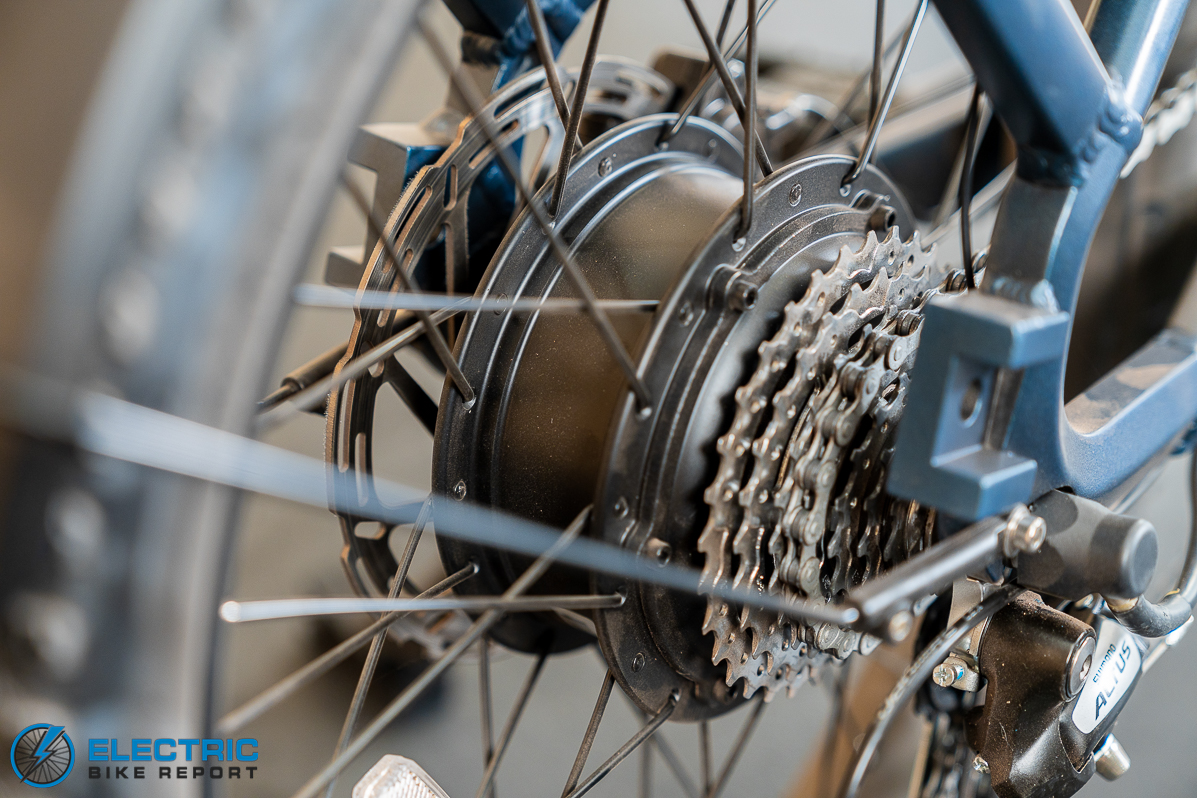
The Portola uses a current-based programming system for its powerful 750W hub motor, which provides a more natural feel than a speed-based system.
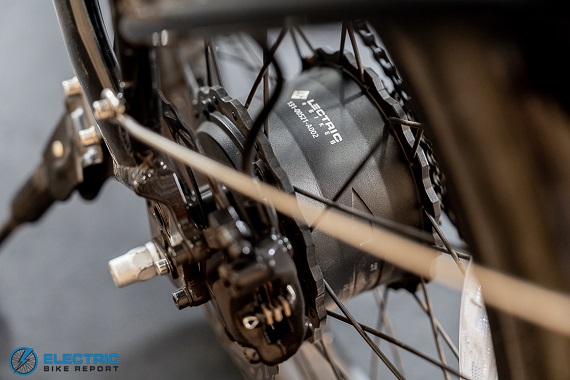
The XP 3.0 is equipped with a 500W rear hub motor. Like the Portola, it uses a cadence sensor with current-based programming.
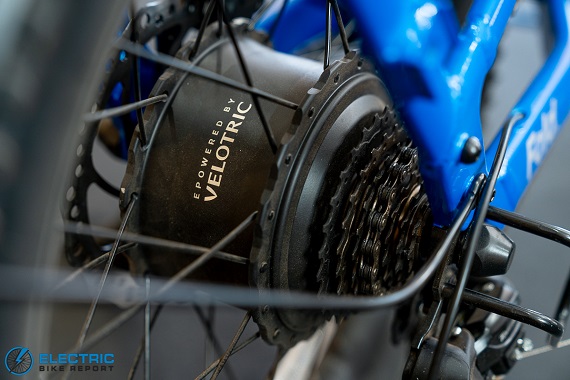
While the Fold 1 is also equipped with a 750W hub motor, it uses a more traditional speed-based programming system.
Hill Test Results:
| Lectric XP 3.0 | Ride1Up Portola | Velotric Fold 1 | |
| Throttle | 1:35, 11.4 mph | 1:30, 12.1 mph | 1:59, 9.1 mph |
| Pedal | 1:21, 13.4 mph | 1:17, 14.1 mph | 1:25, 12.8 mph |
We tested the climbing ability of each bike’s throttle and maximum PAS setting at a location called Hell Hole Trail. With an average grade of 12% percent over a third of a mile, it’s painful to pedal up this path without a motor. Our tester, Justin, recorded the times and speeds shown above when using Strava to track segment data.
To explain these results, we must dive into the technical stuff.
On paper, the Velotric Fold 1 has the strongest motor—750 watts of nominal output, 1050W peak, and 70 Newton-meters of torque—but its test results indicate that it is less powerful than its competitors. Clearly, a piece of the puzzle is missing.
At face value, the Portola’s 750W motor seems straightforwardly more powerful than the XP 3.0’s 500W motor, but when considering peak power output, the bikes’ results are put into perspective.
With a peak of 960 watts and 65 Newton meters of torque, the Portola’s motor is relatively reserved for its size, while the XP’s peak of 1000 watts and 55 Newton meters of torque makes it on the more powerful side based on nominal wattage. Essentially, the bikes were evenly matched; the small difference in test results is within the normal margin of error.
Bottom line: all three bikes are capable of handling steep, intimidating hills with throttle or pedal assist, but the Portola and the XP 3.0 proved most effective. We consider these two bikes tied in this category considering their close performance (less than 5 seconds of difference) in both portions of the test.
|
Lectric XP 3.0 |
Ride1Up Portola |
Velotric Fold 1 |
Lectric XP 3.0 vs Ride1Up Portola vs Velotric Fold 1: Brakes (Brake Test)
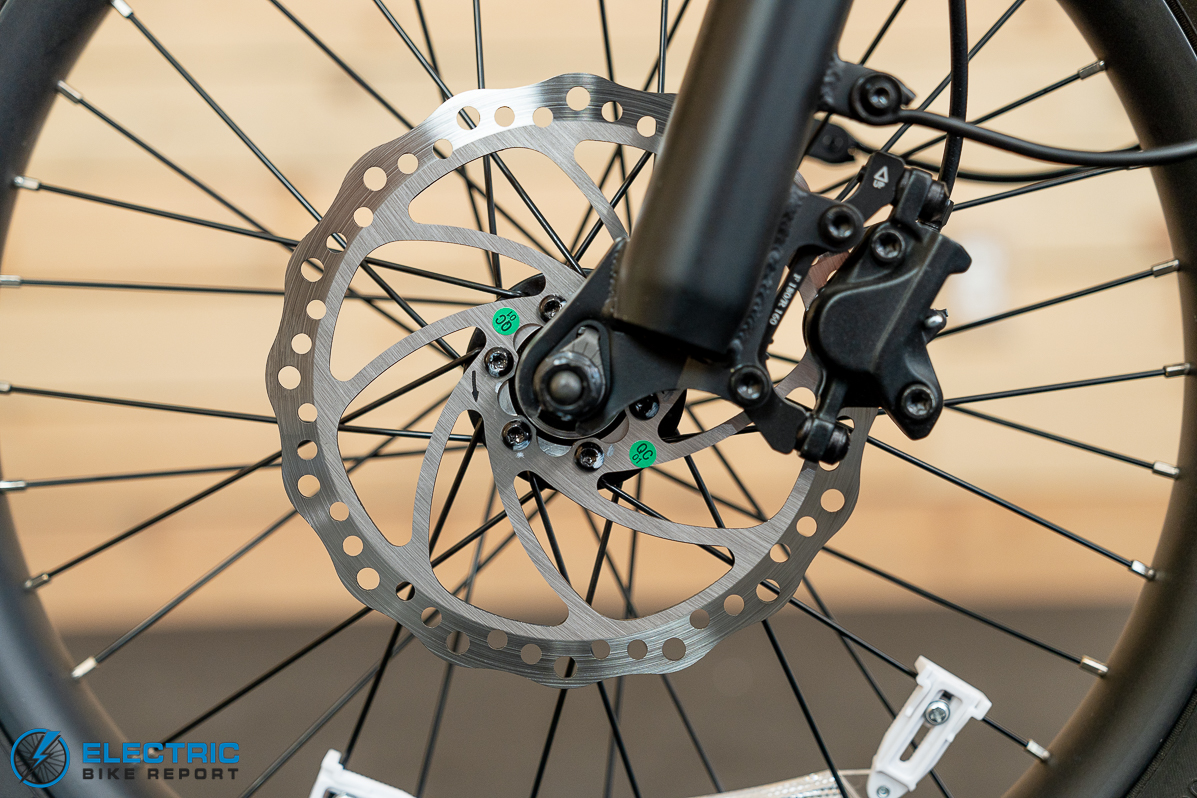
While the Fold 1’s brakes are unbranded, the bike set new records for folding e-bikes in our standardized Brake Test.
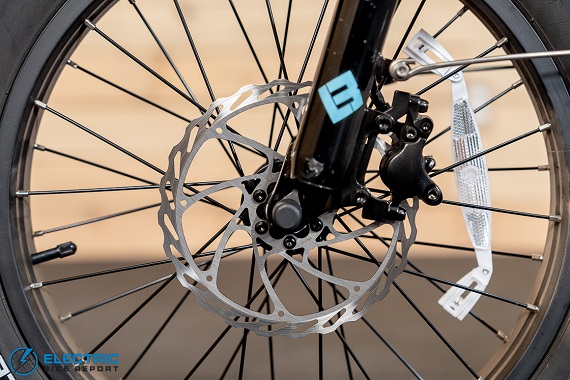
Lectric raised the bar for the industry by being the first to spec an affordable folding bike with hydraulic disc brakes.
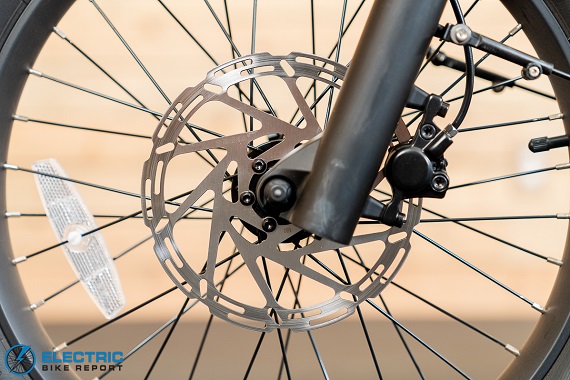
As with the Fold 1 and the XP 3.0, the Portola is equipped with hydraulic disc brakes and 180 mm front and rear rotors.
| Lectric XP 3.0 | Ride1Up Portola | Velotric Fold 1 | |
| Ave Stopping Distance | 21’8” | 20’8” | 16’10” |
We consider all three of the above Brake Test results to be good, but the Velotric Fold 1 clearly came out ahead of the XP 3.0 and the Portola. At the time of our review of the Fold, it set a new record for average stopping distance when compared to other folding e-bikes we tested with hydraulic disc brakes.
All three bikes share many of the characteristics we usually associate with Brake Test performance. They are equipped with similar brake systems and tires, and they weigh approximately 60 lbs each.
The Fold 1’s battery placement may have affected its results, but there is no clear reason why its performance was so different. As such, we attribute the Fold 1’s above-average performance primarily to its brake system. Unfortunately, the brake systems on all three bikes are unbranded, so we don’t know who manufactured them (or what brand to credit).
In the big picture, all three bikes are specced well with effective brake systems, so you really can’t go wrong with any option.
Lectric XP 3.0 vs Ride1Up Portola vs Velotric Fold 1: Speed Capabilities (Speed Test)

The XP 3.0 is arguably the most popular e-bike in the US, as Lectric defined what was possible for an affordable cost and reputable quality.
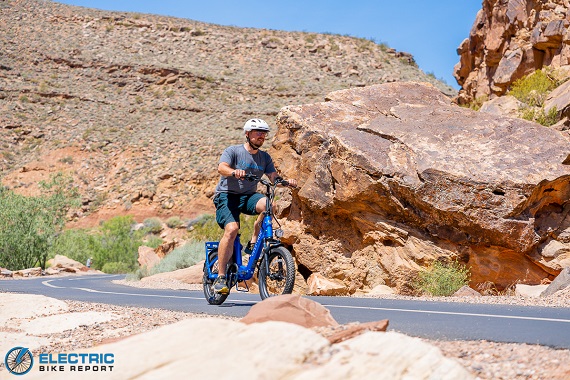
Velotric entered the e-bike market later than Ride1UP and Lectric, but the Fold 1 is proof that they’ve quickly caught up.
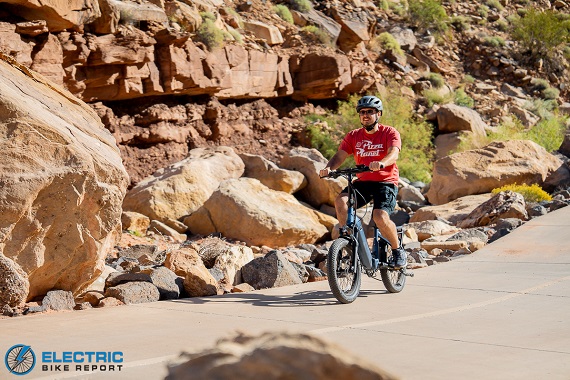
The Portola marked the first real challenger to Lectric’s crown; with features like a 750W hub motor, they also raised the bar.
The above Speed Test results were gathered when testing the XP 3.0, the Portola, and the Fold 1 on our local network of paved bike paths. As indicated by the dark and light graphs, we tested all three bikes in their Class 2 settings (as they ship) with throttle and pedal assist limited to 20 mph and their faster Class 3 mode with pedal assist up to 28 mph.
The Class 2 data for the Fold 1 and the Portola both indicated well-balanced pedal assist systems with five distinct levels of power and speed. The XP3 was faster initially and showed a similar pattern in its low assist levels, but its 20-mph speed limit held it back in PAS 4 and 5. This effectively reduced the number of assist levels from 5 to 3.
In the Class 3 test, each bike’s speed/power profile changed by varying degrees. All were faster than they were in Class 2 mode upon reaching PAS 2 (and above).
As shown by the graph above, the XP 3.0 ramped up in speed in PAS 3, then leveled out. The Portola’s speeds increased fairly steadily with more reserved levels of power, but spiked above the others in PAS 5. The Fold 1’s speeds showed a similarly linear pattern of steady speed increases that, in most cases, fell between the XP and the Portola.
All three bikes use cadence sensors, but their two different types of programming result in a difference in feel. The Fold 1’s PAS has pre-set speed limits, so its motor does not require active pedaling to get up to speed. The XP and the Portola use a current-based system that limits power output, so rider effort is required; pedaling felt more engaging and natural.
In terms of throttle power, the bike’s results mirrored their pedal test performance. The XP 3.0 felt punchy and quick while the Portola seemed more approachable and gradual. The Fold 1’s throttle speed is tied to its PAS speed/setting, so it ranged between the two; its low assist levels felt reserved, while the high levels had more punch.
With its more traditional programming and preset throttle speeds, we liked the Fold 1, but we found that the Portola was the ideal middle ground with five fully functional PAS settings and a more responsive feel. With that in mind, riders preferring more speed out of the gate might opt for the XP 3.0.
|
Lectric XP 3.0 |
Ride1Up Portola |
Velotric Fold 1 |
Lectric XP 3.0 vs Ride1Up Portola vs Velotric Fold 1: Components
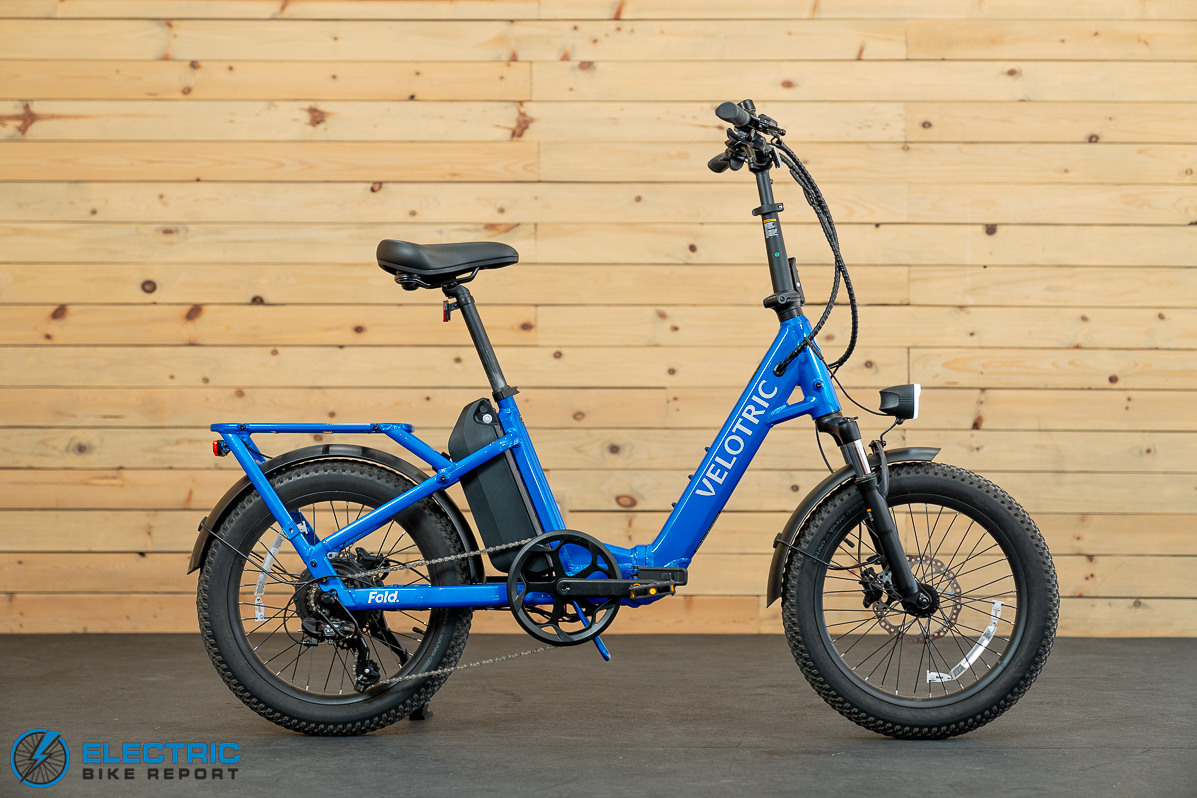
The Fold 1’s design looks great and handles more like a full-size e-bike than what we typically get from a portable folding bike. We found our test bike’s Electric Blue color to be stunning.
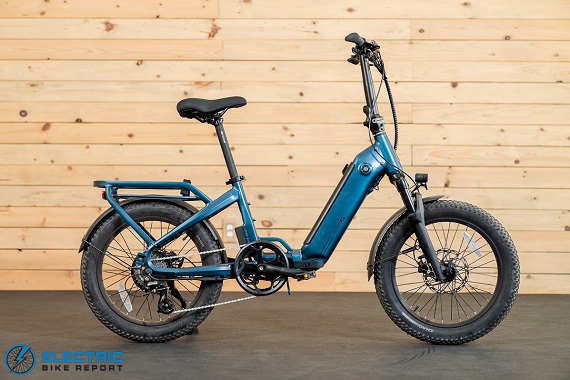
As we’d expect from a Ride1UP e-bike, the Portola has a clean, modern look with a cool matte blue paint option.
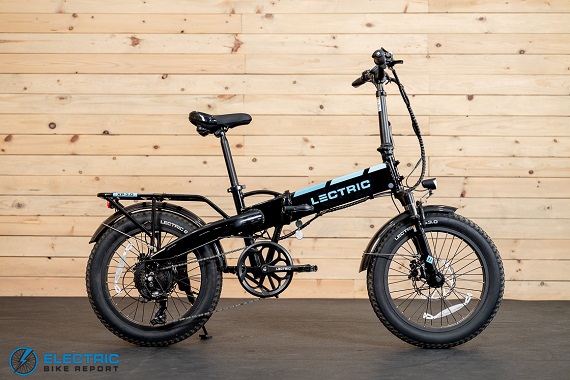
The XP 3.0 is classic and iconic. Where the Portola and the Fold only come in a step-thru design, the XP has a high-step frame as well.
The three models include many similar components. Each is equipped with 20×3” knobby tires, hydraulic disc brake systems with 180mm rotors, passenger-capable cargo racks, fenders, lights, and black-and-white display units.
The XP 3.0’s highlights include its high-capacity cargo rack (capable of 150 lbs), its full-size central display, its twist throttle, and its pre-slimed tires. Additionally, it is UL 2271 and UL 2849 certified.
On the other hand, the XP’s suspension fork has the shortest travel, and the bike’s handlebars use press-fit faux leather grips. It is specced with an entry-tier 7-speed drivetrain with an over-bar shifter, though we found the drivetrain to be geared well to allow active pedaling while in Class 2 mode.
The Portola’s strengths are its higher (nominal) power motor, its higher-tier 8-speed drivetrain including a better derailleur and trigger shifter, and its high 80-mm-travel suspension fork. We also liked its locking rubber grips, its included securing strap for holding the folded bike together, and for those with a preference, its thumb throttle.
In contrast, the Portola’s weaknesses are its small handlebar-mounted display and, for those in New York, the fact that it is not (at the time of writing) UL 2849 certified.
The Fold 1 stands out with the greatest overall payload capacity of 440 lbs (!), a high-capacity 608-Wh battery, and both UL 2271 and UL 2849 certification. We also appreciated the bike’s wide handlebars with locking rubber grips, its trigger-style shifter, and its securing strap.
The Velotric’s downsides are its limited 120-lb-rated cargo rack (the smallest of the three), its handlebar-mounted display, and its 7-speed drivetrain and entry-tier derailleur. At the time of writing, it also has a higher price, though both other models have battery/range upgrade options that raise their prices to match.
To be thorough, we must also consider the bikes’ included bonus accessories. At the time of writing, Ride1Up offers none. Lectric has added value to both models of the XP by including a few useful accessories, including a larger saddle and a suspension seatpost. The Fold 1’s extras include a side mirror and a phone mount.
Ultimately, we feel that the differences between the three bikes are largely balanced, though one aspect of the Portola swayed our decision. The bike’s upgraded drivetrain noticeably improved the ride, narrowly earning the bike our award in this category.
Lectric XP 3.0 vs Ride1Up Portola vs Velotric Fold 1: Ride Quality
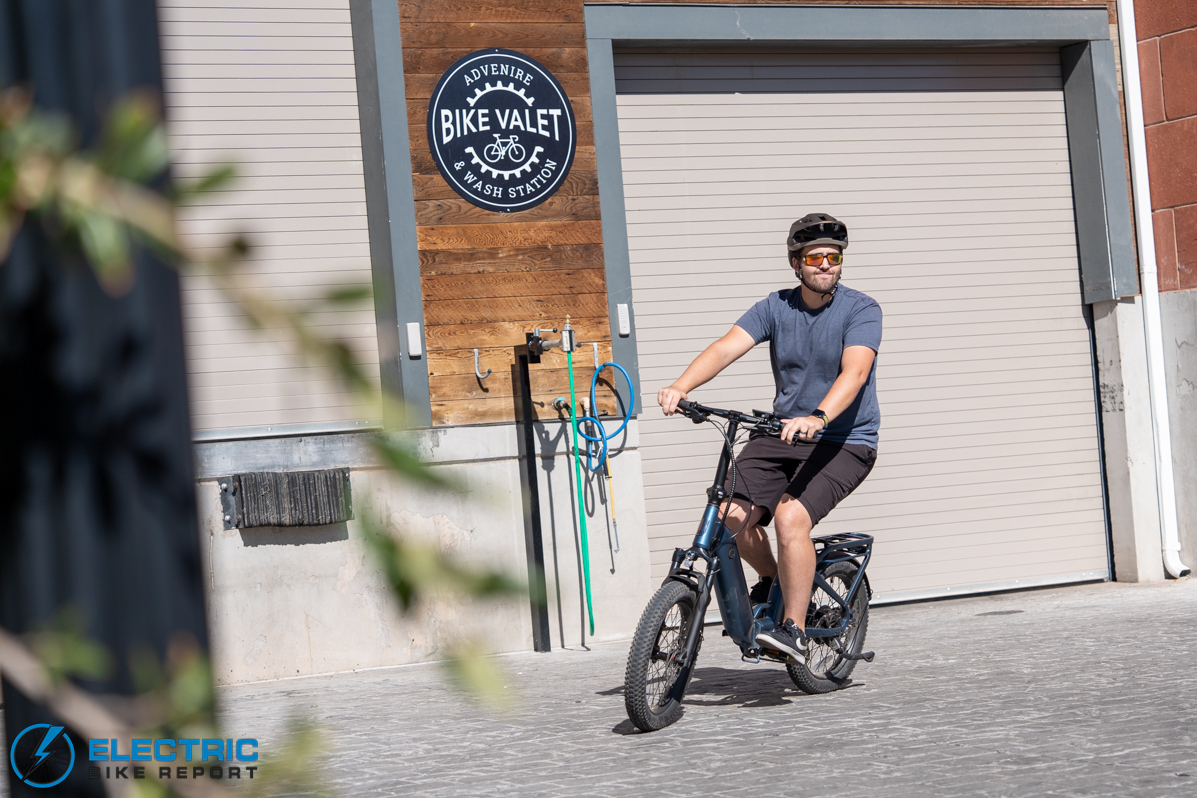
We named the Portola the Best Folding E-Bike for Small-Medium Riders on our list of the Best Fat Tire E-Bikes due to its shorter reach and seatpost length. Taller riders may want to stick with the throttle.
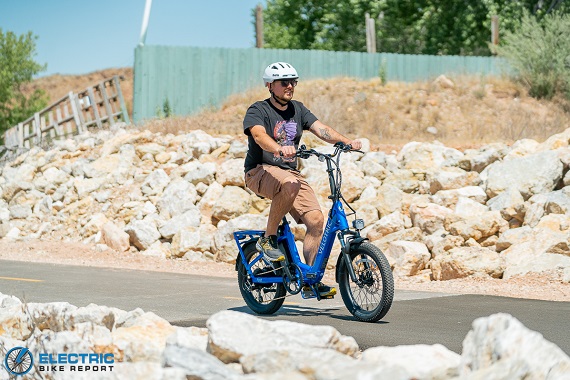
The Fold 1 is a great fit for tall and short riders alike. Its 440-lb payload capacity rivals many cargo e-bikes we’ve tested.
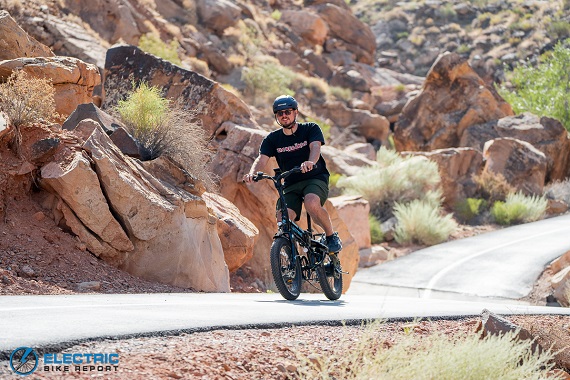
Due to its larger sizing, the XP 3.0 also made our Best Fat Tire list as the Best Folding E-Bike for Medium-Large riders.
Something to be aware of: with their hinged frames and collapsing handlebars, folding e-bikes must strike a tricky balance of functionality and practicality. We usually expect some tradeoffs in handling and comfort; in many cases, folding bikes have longer reach and twitcher handling than a full-size, non-folding e-bike.
The XP 3.0 is sized to be best suited for average to tall riders due to its wide handlebars, long reach, and total payload capacity of 330 lbs. We appreciated its predictable steering, the engaging pedal experience of its drivetrain, and its relatively natural current-based pedal assist system programming.
We found the Portola to be comfortable, though we found that its sizing was best for shorter-to-average riders. We also found much to enjoy with its shorter wheelbase and more agile handling, the ease of operation and responsive shifting from its upgraded drivetrain, its current-based programming, and its cushy 80-mm suspension travel.
Like the XP, the Fold 1 was sized better for average to large riders, which was reinforced by its high payload capacity. The bike had a highly ergonomic fit that felt more like a full-size bike. We also liked its saddle, its throttle’s easy speed control, and its wider handlebars and resultingly precise steering.
Once again, we found that there were tradeoffs between the aspects of ride quality between the three bikes. In the end, we determined that this category was another tie between them; all had strengths and weaknesses that balanced out, so no single bike stood out from the others.
Lectric XP 3.0 vs Ride1Up Portola vs Velotric Fold 1: Which Should You Choose?
To declare which of the three is best overall, we must consider the following categories for comparison:
Specs: The Portola edged out the competition in this category—but just barely. We liked the XP3’s high-capacity cargo rack, the Fold 1’s larger battery and payload capacity, and both bikes’ full UL Certification. Portola’s upgraded drivetrain and fewer downsides overall made it the better choice by a small margin.
Motor: By another slim margin, the Portola proved best; it blends the best characteristics of the other two bikes. It is similar to the XP 3.0 in that it shares current-based pedal assist programming and around 1000W of peak power. Like the Fold 1, it has an excellent balance of speed/power levels, making it approachable to a wide range of riders.
Hill Climbing Ability: The XP 3.0 and Portola tied in this category. While the Fold 1 fell behind by a significant margin in our throttle test, the Lectric and the Ride1Up shared similar peak motor power and faster, extremely close Hill Test results in both portions of the test.
Range: Velotric and Lectric share a win in this category for different reasons. The XP 3.0 proved better able to cover large distances at higher power levels and speeds, while the Fold 1 greatly exceeded the capabilities of the other bikes at low speeds. The upgraded XP would likely do even better.
Ride Quality: All three bikes are tied in this category, again for different reasons. We liked the XP’s full-size central display, the Portola’s crisp shifting, and the more natural-feeling current-based programming of both bikes. The Fold 1 had comfortable geometry, an enjoyable riding position, and user-friendly control over its throttle speed.
Value for the Money: As the lower-priced options, the XP 3.0 and the Portola are tied. Due to its drivetrain and motor, the base model of the Portola offers the best entry-level value. With a higher battery capacity and (currently) free comfort accessories, including a larger saddle and suspension seatpost, the upgraded XP 3.0 wins at the highest price point.
The Ride1Up Portola earned top marks in five categories (Specs, Motor, Hill Climbing, Ride Quality, and Value) versus three wins for the Lectric XP 3.0 and two for the Velotric Fold 1. Based on this data, it earns our recommendation as the best affordable folding e-bike option between these three contenders.
We liked its approachable yet powerful motor, relatively natural-feeling pedal experience, comfortable ride, overall value, and clean design. It’s likely to be the best option for you if you’re seeking the best buy at the lowest price, if you’re shorter-to-average in height, or if you prefer a wide range of power levels.
The XP 3.0 might be a better option for average-to-large riders who prefer an overall punchier feel, but it should also suit those who prefer a familiar brand or riders looking for the best value at the upgraded price point. We liked its power, its user interface, and its included freebies.
We think the Fold 1 would be best for riders who want the longest-range option as long as they’re comfortable riding slower. It’s likely suited to those who want precise control over their speeds, those who might not want to pedal actively, or larger riders who need a high payload capacity. We liked its looks, its throttle control, and its overall comfort level.
At least for now, Ride1UP has won the battle, but the affordable folding e-bike war is far from over! We expect that Lectric and Velotric will continue to improve their models in an effort to usurp the new tenant of the throne.
Stay tuned for our next comparison between these bikes and plenty of other reviews and head-to-head battles between highly popular e-bikes!
|
Lectric XP 3.0 |
Ride1Up Portola |
Velotric Fold 1 |



Thorough and indepth comparison
Thanks for reading!